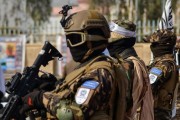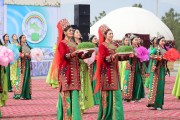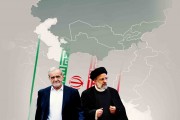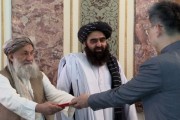Publish Date
Saturday 14 October 2023 - 12:35
recommended
0
The multivectoral Great Game in Central Asia: Nature and Strategic Implications
The complexity of multi-layered and multi-faceted relations in Central Asia naturally has many strategic outputs, which can also be considered as part a multi-faceted new Great Game in the region. Among the most important outputs is the increase of the extra-regional influence of Central Asia through the emergence of regional initiatives. In fact, political, security, and especially, geo-economic initiatives in this region will clearly affect international trends and even the new order in the structure of the international system.
By: Omid Rahimi
Introduction
During the past three decades, Central Asia has gone through a long transition period. This transition period has not yet ended and is at a critical stage. The intersection of the interests of major international players and regional powers, along with fundamental changes in the structure of the international system, has made this transition period more complicated. This period can be Percieved as a multivectoral Great Game that has fundamental distictions with 19h Century Great Game and even with the theorized New Great Game in the last two decades.
In this context, the identification of interests as well as short and long-term measures, in order to achieve the predetermined goals, usually have more complications and costs. Reducing these costs requires identifying the dynamics of conflict and alignment of interests, as well as understanding the political and international trends at the right time and place. In such a situation, it is necessary for the political actors of the region to admit the new conditions, have an actual understanding of the dynamics, and to design short-term, medium-term and long-term strategies. In this analysis, the background and drivers of the new conditions as well as its nature and characteristics are explained, and finally its strategic outputs would be evaluated. This analysis aims to identify the policy requirements of the Islamic Republic of Iran, with a focus on Central Asia and, on a broader level, in the neighboring policy.
Drivers and background
Many factors have been involved in the formation of the multivectoral Great Game in Central Asia, of which the decline of Russian role is the main factor. While it was expected that with Vladimir Putin's return to power and the revival of the Eurasianism policy in Russia, we would see the revival of Russia's regional hegemony in Central Asia, but regional trends proved that this process is basically irreversible in the current situation. Therefore, the decline of Russia was accepted as an inevitable reality in the region.
Along with that, we witnessed the peaceful rise of China with greater depth in Central Asia. Since the announcement of the Belt and Road Initiative by Xi Jinping's government in 2013, and the redefinition of China's geo-economic and geo-strategic interests in Central Asia, China's role in this region has also changed parallel to the international level. The rise of China was the first step for evolving the new multivectoral Great Game in Central Asia.
Another important development has been the emergence of gaps in the role of the Western Front in Central Asia. Over the past decade, the United States, the European Union, and other European actors have been less aligned and have not had unified operational approaches in Central Asia. In some areas, this behavioral distinction has had a competitive and conflicting nature and has suffered divergence. This divergence has been clearly visible in strategic policies, such as regional geo-economy, energy transfer policies, security approaches to fundamental threats in the region, and especially the type of interaction with powerful regional oligarchy cults. Of course, this does not mean the lack of general convergence of Western actors in Central Asia, but rather it indicates a kind of functional distinction and the lack of concentration of resources and goals, which has caused a decrease in the influence of the West.
During recent years, three other key factors have also clearly reinforced these trends and led to the early formation of the multivectoral Great Game in Central Asia. As the first and most significant factor we can mention the change in situation in Afghanistan as Taliban gained power following the withdrawal of the international coalition forces. While before this situation, Central Asia played a key role in Afghanistan for almost two decades, since then it has emerged as an independent factor, and especially, an influential actor in Afghanistan. This caused a kind of change in regional political and security dynamics. At the same time, a significant part of the costs of America's withdrawal from Afghanistan was imposed on the vulnerable Central Asian Republics, which could affect the role of these countries if the West does not take the responsibility. Therefore, a new level of interaction between Central Asia and the West has been formed focused on Afghanistan.
The second factor is the war in Ukraine, which negatively and positively influenced the dynamics of convergence and conflict in Central Asia at three regional, interregional and international levels. The enhanced polarization between Russia and the West at the international level spread to Central Asia (as Russia's - and to some extent China's - most secure periphery). This situation imposed costs on the countries of the region and, consequently, led to new behaviors.
The third factor is deepening of the influence of emerging regional powers, which has been significantly strengthened during the last year due to the Ukraine war. During the last decade, Central Asian countries have strategically focused on developing relations with regional powers, based on a long-term balancing policy. Since the 2022 war in Ukraine this balancing strategy has become a vital imperative in the foreign policy of these countries. It gives capabilities to countries such as Turkey, Iran, India, Japan, South Korea, the United Arab Emirates, and Saudi Arabia to help counterbalancing international powers in Central Asia. Of course, it should be noted that this balancing capability is naturally not possible in isolation, and it creates significant weight in a positive-sum game.
Nature and characteristics
Given that the traditional Great Game was in the form of a strategic and geopolitical confrontation, and the new Great Game was theorized in the form of an economic and political competition in the 1990s and 2000s, understanding the nature and characteristics of the multivectoral Great Game is more difficult and complicated than the previous ones. The main factor for this complexity is the network-like nature of this game, which has spread from the international level to the regional levels, instead of the traditional bipolar ones. Despite this, some features can be mentioned as the key characteristics of this new Great Game.
Multilateralism on the surface and bilateralism in depth is the most important characteristic of the new Great Game, and the main factor of its multivectoral nature. Almost all the influential actors in Central Asia have developed institutional structures in the political, security and economic frameworks in the region, and have seriously put multilateralism in the form of the 5+1 platform on their agenda. Functionally, these multilateral platforms have a lot in common, while the type of interaction they have with each other is not clearly known. In the final statements of the meetings of the 5+1 countries of the region with China, Russia and even the West, there are common propositions such as security, independence, economic development and respect for the territorial integrity of the regional countries. Basically, no direct action has been observed in these platforms to undermine the other platform.
On the other hand, the functional effectiveness of these platforms at operational levels is still uncertain. At the same time, during these multilateral approaches, all these actors have formed stronger bilateral ties that have had clear conflict dynamics. Therefore, the incompatibile behavior of these actors in mentioned platforms, and its acceptance by the countries of the region in the framework of a political conservatism, is the most important uncertainty that has made the competitions in the region multivectored. The main reason for the separation of the strategic policies of some European countries from the coherent approaches of the European Union towards Central Asia has actually been this.
The emergence of Central Asia as an independent region is the second major feature of the new Great Game. While even the West had previously recognized Central Asia as a sub-system of the Eurasian inter-regional system with a minimal role of regional actors, it seems that with the change to the foreign policy approach of Uzbekistan and subsequently Kazakhstan, an independent regionalism is evolving in central Asia. The first sign of this process was the first consultative meeting of the heads of Central Asian countries, and its regular continuation during the following years, as well as the permanent resolution of some deep regional issues without major powers in the shadow of this convergence. This process has various meanings, including giving a strong role to countries like Uzbekistan and Kazakhstan and actually recognizing their interests and identity, reducing the predictability of the behavior of regional actors, deepening the convergence of small and large countries in the region, and subsequently reducing tensions, decreasing the contradictory acting of Great Powers, and finally the emergence of an independent regionalism in Central Asia.
Multivectoredacting which emerged as a new political imperative in the region and then as a feature of the new regional conditions, is the third feature of the multifaceted Great Game in Central Asia. The major players have defined the mechanisms of cooperation and competition in multi-layered frameworks, and sometimes they have shown behaviors that are contrary to their principled approaches. The convergent actions of Russia and the West to weaken or limit China's influence in the region and vice versa, and the intangible cooperation between China and the West to bypass Russia after the Ukraine war are examples of this acting. In addition, in the functional and operational areas, there have been changes in the policy of key actors, in a way that includes conflict between different goals and interests. The contradictory behavior of the United States towards its economic, political and security goals, which was noticeably observed in the developments of last January in Kazakhstan and the protests before it, is a clear example of this feature.
In sum, the dominance of geo-strategy and the transition from single-sided acting in the political, economic and even security fields can be considered the most important characteristic of the new multi-sided acting, which has also overshadowed other dimensions. In some analyses, this approach is influenced by the multivectored definition of security in new schools.
The most important strategic outputs
Such complexities caused by multi-layered and multivectored relationships obviously result in many strategic outputs, which can be considered as part of the features of the multivectored Great Game. Among the most important outputs is the increase of the extra-regional sphere of influence of Central Asia due to the emergence of regional initiatives. In fact, political, security and especially geo-economic initiatives in this region will clearly affect international trends and even the new order in the structure of the international system. The most important factor in creating this strategic output is the change in the outlook and approach of different actors, as well as the geopolitical vacuum that has emerged as a result of the new conditions and has created a region without a dominant hegemony.
The second output is the complexity and intensification of competition between regional and international players. It has caused a collision between common and conflicting interests. These uncalculated collisions and calculation mistakes will cause relative instability and create more uncertainty. This means that the predictable and relatively calm region of Central Asia during the past two decades is likely to become a hotbed of tension in the near future - although it will be on the verge of some kind of balance-oriented relative stability due to the focus of regional countries.
The third output of the new conditions is an increase in the cost of acting with a focus on long-term benefits. The increase in the level of tensions as well as the interference of regional and international actors with different levels of power (in general) and with the power of influence in the region (in Central Asia) will lead to an increase in proxy encounters. This imbalance of power levels will itself be a factor in imposing unforeseen costs. At the same time, multivectored acting, by itself, requires conflicting behaviors towards interests with different priorities, which also requires spending excess costs. Finally, the long-term approach of the actors, especially in the field of geo-economics, is considered to be a kind of improvement of the level of acting in the region, which will also require significant expenses.
In the meanwhile, the relative advantages - even if minimal - will have a double effect, and it is considered as a strategic output by itself. Although before this, the Central Asian countries were considered merely pragmatic actors with predetermined realistic interests, in the new conditions where multifaceted games have become common in the region, some relative advantages such as cultural-historical commonalities, geographical proximity in localist formats, and of course, the idealistic views of identity will be more effective and visible.
The final outcome is the transformation of regional dynamics into a positive-sum game. This situation arises due to the multi-layered complexity of games, and the interactions of different actors. In such a context, different governments should distance themselves from traditional views and end their rigid approaches in foreign policy towards Central Asia, in order to achieve their interests. This transformation can create new patterns of friendship and enmity in Central Asia.
Conclusion
Central Asia is changing. This transition has been achieved not only through processes, but also at deeper levels through changes in intra-regional, inter-regional and even international dynamics. In such a context, realizing the interests of the Islamic Republic of Iran in the near future will require an actual understanding of the new situation, along with applying a strategic flexibility in foreign policy. Besides this, Tehran should come out of the traditional framework of Middle Eastern behavior in foreign policy, and focus on new areas in accordance with the new conditions. At the same time, the traditional and optimistic view of Central Asia as the only safe region and almost free of direct threats to Iran should gradually be set aside from the security doctrine of the Islamic Republic of Iran, and replaced by expanded, multi-layered and future-oriented aproaches that are suitable for the new transition era.
In the future, part of the developments in Iran's surrounding environment, and in the system of international dynamism will soon be determined in Central Asia. In such a context, a planned, flexible and agile presence, along with the necessary software and hardware supports, will guarantee the mutual interests of Iran and Central Asia.
Omid Rahimi, is the Researcher Fellow at the Institute of East Strategic Studies.
Introduction
During the past three decades, Central Asia has gone through a long transition period. This transition period has not yet ended and is at a critical stage. The intersection of the interests of major international players and regional powers, along with fundamental changes in the structure of the international system, has made this transition period more complicated. This period can be Percieved as a multivectoral Great Game that has fundamental distictions with 19h Century Great Game and even with the theorized New Great Game in the last two decades.
In this context, the identification of interests as well as short and long-term measures, in order to achieve the predetermined goals, usually have more complications and costs. Reducing these costs requires identifying the dynamics of conflict and alignment of interests, as well as understanding the political and international trends at the right time and place. In such a situation, it is necessary for the political actors of the region to admit the new conditions, have an actual understanding of the dynamics, and to design short-term, medium-term and long-term strategies. In this analysis, the background and drivers of the new conditions as well as its nature and characteristics are explained, and finally its strategic outputs would be evaluated. This analysis aims to identify the policy requirements of the Islamic Republic of Iran, with a focus on Central Asia and, on a broader level, in the neighboring policy.
Drivers and background
Many factors have been involved in the formation of the multivectoral Great Game in Central Asia, of which the decline of Russian role is the main factor. While it was expected that with Vladimir Putin's return to power and the revival of the Eurasianism policy in Russia, we would see the revival of Russia's regional hegemony in Central Asia, but regional trends proved that this process is basically irreversible in the current situation. Therefore, the decline of Russia was accepted as an inevitable reality in the region.
Along with that, we witnessed the peaceful rise of China with greater depth in Central Asia. Since the announcement of the Belt and Road Initiative by Xi Jinping's government in 2013, and the redefinition of China's geo-economic and geo-strategic interests in Central Asia, China's role in this region has also changed parallel to the international level. The rise of China was the first step for evolving the new multivectoral Great Game in Central Asia.
Another important development has been the emergence of gaps in the role of the Western Front in Central Asia. Over the past decade, the United States, the European Union, and other European actors have been less aligned and have not had unified operational approaches in Central Asia. In some areas, this behavioral distinction has had a competitive and conflicting nature and has suffered divergence. This divergence has been clearly visible in strategic policies, such as regional geo-economy, energy transfer policies, security approaches to fundamental threats in the region, and especially the type of interaction with powerful regional oligarchy cults. Of course, this does not mean the lack of general convergence of Western actors in Central Asia, but rather it indicates a kind of functional distinction and the lack of concentration of resources and goals, which has caused a decrease in the influence of the West.
During recent years, three other key factors have also clearly reinforced these trends and led to the early formation of the multivectoral Great Game in Central Asia. As the first and most significant factor we can mention the change in situation in Afghanistan as Taliban gained power following the withdrawal of the international coalition forces. While before this situation, Central Asia played a key role in Afghanistan for almost two decades, since then it has emerged as an independent factor, and especially, an influential actor in Afghanistan. This caused a kind of change in regional political and security dynamics. At the same time, a significant part of the costs of America's withdrawal from Afghanistan was imposed on the vulnerable Central Asian Republics, which could affect the role of these countries if the West does not take the responsibility. Therefore, a new level of interaction between Central Asia and the West has been formed focused on Afghanistan.
The second factor is the war in Ukraine, which negatively and positively influenced the dynamics of convergence and conflict in Central Asia at three regional, interregional and international levels. The enhanced polarization between Russia and the West at the international level spread to Central Asia (as Russia's - and to some extent China's - most secure periphery). This situation imposed costs on the countries of the region and, consequently, led to new behaviors.
The third factor is deepening of the influence of emerging regional powers, which has been significantly strengthened during the last year due to the Ukraine war. During the last decade, Central Asian countries have strategically focused on developing relations with regional powers, based on a long-term balancing policy. Since the 2022 war in Ukraine this balancing strategy has become a vital imperative in the foreign policy of these countries. It gives capabilities to countries such as Turkey, Iran, India, Japan, South Korea, the United Arab Emirates, and Saudi Arabia to help counterbalancing international powers in Central Asia. Of course, it should be noted that this balancing capability is naturally not possible in isolation, and it creates significant weight in a positive-sum game.
Nature and characteristics
Given that the traditional Great Game was in the form of a strategic and geopolitical confrontation, and the new Great Game was theorized in the form of an economic and political competition in the 1990s and 2000s, understanding the nature and characteristics of the multivectoral Great Game is more difficult and complicated than the previous ones. The main factor for this complexity is the network-like nature of this game, which has spread from the international level to the regional levels, instead of the traditional bipolar ones. Despite this, some features can be mentioned as the key characteristics of this new Great Game.
Multilateralism on the surface and bilateralism in depth is the most important characteristic of the new Great Game, and the main factor of its multivectoral nature. Almost all the influential actors in Central Asia have developed institutional structures in the political, security and economic frameworks in the region, and have seriously put multilateralism in the form of the 5+1 platform on their agenda. Functionally, these multilateral platforms have a lot in common, while the type of interaction they have with each other is not clearly known. In the final statements of the meetings of the 5+1 countries of the region with China, Russia and even the West, there are common propositions such as security, independence, economic development and respect for the territorial integrity of the regional countries. Basically, no direct action has been observed in these platforms to undermine the other platform.
On the other hand, the functional effectiveness of these platforms at operational levels is still uncertain. At the same time, during these multilateral approaches, all these actors have formed stronger bilateral ties that have had clear conflict dynamics. Therefore, the incompatibile behavior of these actors in mentioned platforms, and its acceptance by the countries of the region in the framework of a political conservatism, is the most important uncertainty that has made the competitions in the region multivectored. The main reason for the separation of the strategic policies of some European countries from the coherent approaches of the European Union towards Central Asia has actually been this.
The emergence of Central Asia as an independent region is the second major feature of the new Great Game. While even the West had previously recognized Central Asia as a sub-system of the Eurasian inter-regional system with a minimal role of regional actors, it seems that with the change to the foreign policy approach of Uzbekistan and subsequently Kazakhstan, an independent regionalism is evolving in central Asia. The first sign of this process was the first consultative meeting of the heads of Central Asian countries, and its regular continuation during the following years, as well as the permanent resolution of some deep regional issues without major powers in the shadow of this convergence. This process has various meanings, including giving a strong role to countries like Uzbekistan and Kazakhstan and actually recognizing their interests and identity, reducing the predictability of the behavior of regional actors, deepening the convergence of small and large countries in the region, and subsequently reducing tensions, decreasing the contradictory acting of Great Powers, and finally the emergence of an independent regionalism in Central Asia.
Multivectoredacting which emerged as a new political imperative in the region and then as a feature of the new regional conditions, is the third feature of the multifaceted Great Game in Central Asia. The major players have defined the mechanisms of cooperation and competition in multi-layered frameworks, and sometimes they have shown behaviors that are contrary to their principled approaches. The convergent actions of Russia and the West to weaken or limit China's influence in the region and vice versa, and the intangible cooperation between China and the West to bypass Russia after the Ukraine war are examples of this acting. In addition, in the functional and operational areas, there have been changes in the policy of key actors, in a way that includes conflict between different goals and interests. The contradictory behavior of the United States towards its economic, political and security goals, which was noticeably observed in the developments of last January in Kazakhstan and the protests before it, is a clear example of this feature.
In sum, the dominance of geo-strategy and the transition from single-sided acting in the political, economic and even security fields can be considered the most important characteristic of the new multi-sided acting, which has also overshadowed other dimensions. In some analyses, this approach is influenced by the multivectored definition of security in new schools.
The most important strategic outputs
Such complexities caused by multi-layered and multivectored relationships obviously result in many strategic outputs, which can be considered as part of the features of the multivectored Great Game. Among the most important outputs is the increase of the extra-regional sphere of influence of Central Asia due to the emergence of regional initiatives. In fact, political, security and especially geo-economic initiatives in this region will clearly affect international trends and even the new order in the structure of the international system. The most important factor in creating this strategic output is the change in the outlook and approach of different actors, as well as the geopolitical vacuum that has emerged as a result of the new conditions and has created a region without a dominant hegemony.
The second output is the complexity and intensification of competition between regional and international players. It has caused a collision between common and conflicting interests. These uncalculated collisions and calculation mistakes will cause relative instability and create more uncertainty. This means that the predictable and relatively calm region of Central Asia during the past two decades is likely to become a hotbed of tension in the near future - although it will be on the verge of some kind of balance-oriented relative stability due to the focus of regional countries.
The third output of the new conditions is an increase in the cost of acting with a focus on long-term benefits. The increase in the level of tensions as well as the interference of regional and international actors with different levels of power (in general) and with the power of influence in the region (in Central Asia) will lead to an increase in proxy encounters. This imbalance of power levels will itself be a factor in imposing unforeseen costs. At the same time, multivectored acting, by itself, requires conflicting behaviors towards interests with different priorities, which also requires spending excess costs. Finally, the long-term approach of the actors, especially in the field of geo-economics, is considered to be a kind of improvement of the level of acting in the region, which will also require significant expenses.
In the meanwhile, the relative advantages - even if minimal - will have a double effect, and it is considered as a strategic output by itself. Although before this, the Central Asian countries were considered merely pragmatic actors with predetermined realistic interests, in the new conditions where multifaceted games have become common in the region, some relative advantages such as cultural-historical commonalities, geographical proximity in localist formats, and of course, the idealistic views of identity will be more effective and visible.
The final outcome is the transformation of regional dynamics into a positive-sum game. This situation arises due to the multi-layered complexity of games, and the interactions of different actors. In such a context, different governments should distance themselves from traditional views and end their rigid approaches in foreign policy towards Central Asia, in order to achieve their interests. This transformation can create new patterns of friendship and enmity in Central Asia.
Conclusion
Central Asia is changing. This transition has been achieved not only through processes, but also at deeper levels through changes in intra-regional, inter-regional and even international dynamics. In such a context, realizing the interests of the Islamic Republic of Iran in the near future will require an actual understanding of the new situation, along with applying a strategic flexibility in foreign policy. Besides this, Tehran should come out of the traditional framework of Middle Eastern behavior in foreign policy, and focus on new areas in accordance with the new conditions. At the same time, the traditional and optimistic view of Central Asia as the only safe region and almost free of direct threats to Iran should gradually be set aside from the security doctrine of the Islamic Republic of Iran, and replaced by expanded, multi-layered and future-oriented aproaches that are suitable for the new transition era.
In the future, part of the developments in Iran's surrounding environment, and in the system of international dynamism will soon be determined in Central Asia. In such a context, a planned, flexible and agile presence, along with the necessary software and hardware supports, will guarantee the mutual interests of Iran and Central Asia.
Omid Rahimi, is the Researcher Fellow at the Institute of East Strategic Studies.
News code:3570


















